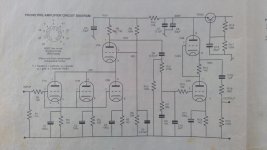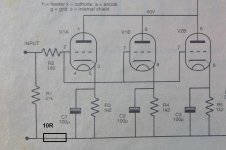Using the circuit shown ( ECC88 tubes ) should the heaters be connected to ground or somewhere between ground and HT ? Each channel's heaters are powered via a TO220 6v regulator but there is way too much hum which instantly disappears the moment I power down. HT is 208v
Attachments
Last edited:
but there is way too much hum which instantly disappears the moment I power down.
By this, do you mean that music will briefly continue to play, but hum will instantly stop?
YOS,
Chris
Using the circuit shown ( ECC88 tubes ) should the heaters be connected to ground or somewhere between ground and HT ? Each channel's heaters are powered via a TO220 6v regulator but there is way too much hum which instantly disappears the moment I power down. HT is 208v
I do not quite understand this (red highlighted text).
Are you using a DC or AC filament supply?
The first stage is a cascode, which has very bad PSRR, so you need a very quiet HT.
You can change the potential devider, that set the voltage for the upper triode. You can use a CCS instead of the R9 or a zener instead of the R6 or both, it may help a bit.
You can change the potential devider, that set the voltage for the upper triode. You can use a CCS instead of the R9 or a zener instead of the R6 or both, it may help a bit.
I built a phono preamplifier with ECC88 tubes, and suffered much from hum. Eventually I could kill most of it. Here are my techniques:
- I connected the negative end of the heater to signal GND at the first tube. I found no advantege of elevating the heater (I tried both).
- I placed so-called Hum Breaking Resistors as described here and here, see the attached part of your circuit.
- I used shielded two-wire cable from the input RCA socket (that is isolated from the chassis). One wire carries the hot, the other the cold from the RCA socket, and the shield is connected to the chassis at the RCA socket end only.
- The mains transformer had stray magnetic field to the 1st stage. Distance and transformer magnetic shielding/orientation could help.
- I connected the negative end of the heater to signal GND at the first tube. I found no advantege of elevating the heater (I tried both).
- I placed so-called Hum Breaking Resistors as described here and here, see the attached part of your circuit.
- I used shielded two-wire cable from the input RCA socket (that is isolated from the chassis). One wire carries the hot, the other the cold from the RCA socket, and the shield is connected to the chassis at the RCA socket end only.
- The mains transformer had stray magnetic field to the 1st stage. Distance and transformer magnetic shielding/orientation could help.
Attachments
If the hum disappaer on power off the problem is around a low filtering on HT or a common mode current due a bad wiring.
If you refer the filaments at 60 volt and check the voltage from each cathode you stay safe but remember to put a capcitor , 1 to 10uF , in parallel to the resistor of partitor to ground.
Regarding wiring if you have a photo is better
Walter
If you refer the filaments at 60 volt and check the voltage from each cathode you stay safe but remember to put a capcitor , 1 to 10uF , in parallel to the resistor of partitor to ground.
Regarding wiring if you have a photo is better
Walter
First of all you don't need three tubes in parallel for mm carts. Secondly ecc88 has the sweetest spot at 80...90v anode to cathode supply. Cascode operation needs very low noise power supply.Fillament lifting will be a problem if you use both triodes in a tube for input tube and cascode tube.As long as the lower tubes are running at 1/3rd of the cascode tube current there will be no gain due to lower transconductance which needs to be higher in the input tube instead of the cascode tube.Again there's no reason in having very low noise input stage with a 270kohm resistor in the passive riaa stage...This schematic lacks reason by all sides.
indeed..it's not a darlington for the capacitance multiplier but that can be easily solved by adding a low noise small current transistor in its base like bf422.
Jabiru did not yet respond on my question but apart from that, why two ECC88's in parallel as first stage? In my opinion just one ECC88 give sufficient input transconductance because he uses only a MM stylus.
The more transconductance, the more that stage is prone to hum. I had some similar problem in the past where I had two ECC88 in parallel as input stage. Whatever I did, I still noticed hum until I made that first stage just a single ECC88 and got rid of that annoying hum then.
The more transconductance, the more that stage is prone to hum. I had some similar problem in the past where I had two ECC88 in parallel as input stage. Whatever I did, I still noticed hum until I made that first stage just a single ECC88 and got rid of that annoying hum then.
That is LAST of all. FIRST he needs to fix the hum. THEN he can start to play with everything else.First of all you don't need...
That is LAST of all. FIRST he needs to fix the hum. THEN he can start to play with everything else.
+1 !!
By this, do you mean that music will briefly continue to play, but hum will instantly stop?
YOS,
Chris
Yes music carries on till HT dies
I do not quite understand this (red highlighted text).
Are you using a DC or AC filament supply?
DC supply, To220 is 1.5A 3 pin regulator
Jabiru did not yet respond on my question but apart from that, why two ECC88's in parallel as first stage? In my opinion just one ECC88 give sufficient input transconductance because he uses only a MM stylus.
The more transconductance, the more that stage is prone to hum. I had some similar problem in the past where I had two ECC88 in parallel as input stage. Whatever I did, I still noticed hum until I made that first stage just a single ECC88 and got rid of that annoying hum then.
This circuit is designed for min 0.5mV output moving coil, I'll post some of the text when I can
This circuit is designed for min 0.5mV output moving coil, I'll post some of the text when I can
Because the filament supply is DC, the hum is not coming from that source.
Can you disconnect one ECC88 at the input without much trouble?
O.K. I must have mixed up two threads here concerning that MM stylus. Sorry, but still it is interesting to do the job with only one ECC88 in front.
Last edited:
- Home
- Amplifiers
- Tubes / Valves
- RIAA using ECC88 tubes

